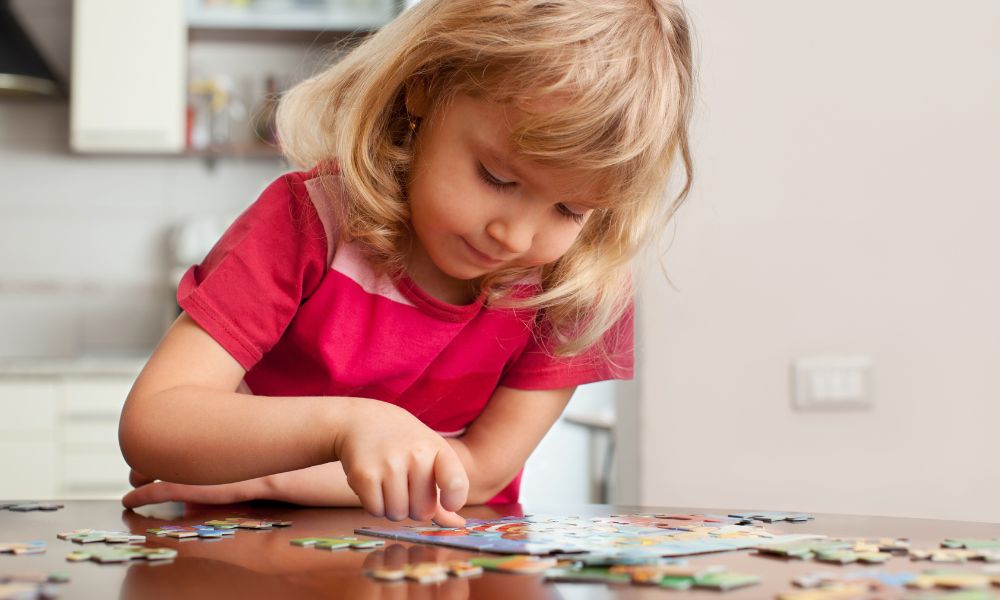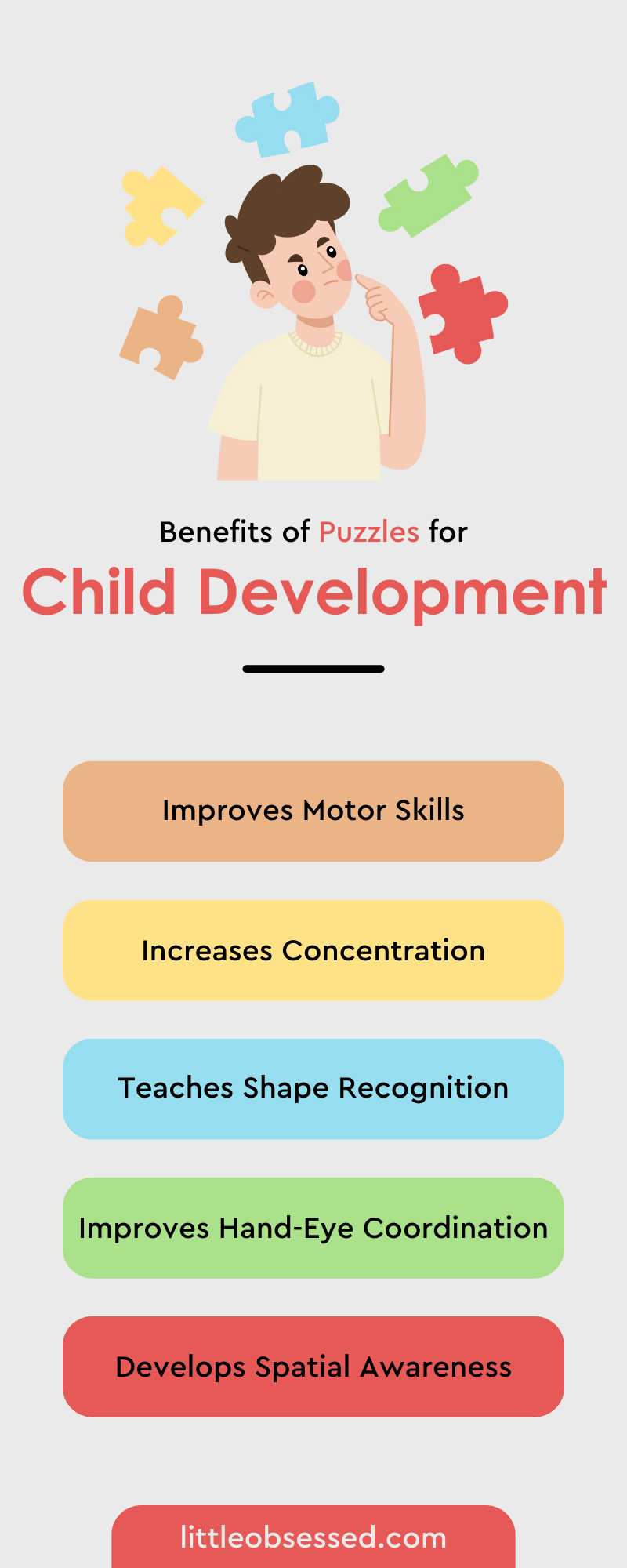10 Benefits of Puzzles for Child Development
10th Jul 2023

Do you want something fun and educational for your little ones? Here are some benefits of puzzles for child development.
Types of Child Puzzles
Puzzles can do wonders for your child’s curiosity, ability to learn, and ability to follow steps. There are two common types of puzzles: inset and jigsaw puzzles. Each uniquely benefits child learning. Let’s go over their differences and what they offer.
Inset Puzzles
Inset puzzles come in three variations: chunky, knob, and peg. Firstly, knobbed puzzles are the simplest puzzle variation for children, where pieces have a non-connecting design that fits into inserts on a piece of wood. Each piece has a knob handle for easy manipulation, hence its name.
Chunky puzzles don’t have knob handles and instead consist of chunky, bulky pieces of wood thicker than the puzzle tray, making for easy movement. They require children to move and manipulate pieces with their hands, which can help strengthen their hand muscles. Lastly, peg puzzles share similarities with knob puzzles but have smaller knob handles. They’re the most challenging types of inset puzzles, and the smaller knobs help preschoolers and toddlers develop motor skills.
Jigsaw Puzzles
Jigsaw puzzles come in floor, frame, and 3D variations, depending on your child’s age and development. Frame puzzles are beginner-friendly puzzle designs with oversized, interlocking pieces made from cardboard. They allow children to learn where pieces go within the frame and are often suitable for kindergarteners and preschoolers.
Floor puzzles assemble directly on the floor without a frame and are a great option for teaching children problem-solving skills. They’re ideal for preschool-aged children and children of all ages and have from 24 to over a hundred pieces. Lastly, 3D puzzles are more challenging, involving the assembly of a three-dimensional shape. They require more time to complete and are often made from wood, foam, and plastic.
Benefits of Puzzles
With so many puzzle variations, you can guarantee hours of fun and education for children. Here are the benefits of puzzles for child development so you can pick up a couple for your little one.
Improves Motor Skills
Allowing your children to play with puzzles can benefit their motor skills. Puzzles can teach children to make small movements in their fingers, hands, wrists, toes, and feet. Learning to pick up and hold pieces while moving and manipulating them into the correct spots can help improve dexterity and focus.
Increases Concentration
Concentration is a significant benefit of puzzle-solving. If you notice your child doesn’t have a developed attention span, puzzles can help build their concentration and help them pay attention. Completing age-appropriate puzzles gives your child a timely task with few interruptions.
If you notice your child constantly giving up, swap out their current puzzles with ones more appropriate to their attention span. However, puzzles should be challenging enough that it can feel gratifying for them.
Teaches Shape Recognition
When children become more attentive to the world around them, playing with puzzles can help them learn to differentiate between shapes, such as squares, circles, rectangles, and triangles. Over time, they know how to recognize the physical properties that make each shape unique.
Furthermore, some puzzles can teach about various physical forms, such as animals, people, vehicles, and more. As children take on more challenging puzzles, they’ll recognize that straight-line pieces only fit on the puzzle’s edge and, in turn, learn about letters and numbers through shape association.
Improves Hand-Eye Coordination
Before your child moves into preschool, puzzles can help them develop hand-eye coordination. Little kids might put their hands in their mouths or in front or above their heads to explore hand-eye coordination. Therefore, puzzles can do wonders for children’s coordination.
Children learn to solve puzzles by moving pieces into place, learning about how to move the piece, and figuring out how to move it where it needs to go. Giving your child independent time to practice can help improve their bodily control.
Develops Spatial Awareness
Puzzle-solving can do wonders for a child’s spatial awareness. As they learn to analyze the colors, shapes, and textures, they can also learn how they fit together. They’ll take the time to learn how to move and flip pieces around to ensure a proper fit in their puzzle.
Over time, trial and error help kids learn to fit pieces together. For that reason, puzzles can teach children to develop movement, distance, and depth perception, improving visuospatial functioning.
Teaches Reasoning and Problem-Solving
Children who play with puzzles can learn basic problem-solving and logical reasoning skills. Because children can’t successfully cheat at jigsaw or inset puzzles, they must learn to use reasoning, problem-solving, and critical thinking skills to their advantage to overcome challenges. The skills they learn can become incredibly valuable in their later years.
As they learn to solve puzzles, they will begin to think more logically and develop different strategies. Learning how to associate pieces by pattern or color and searching for similar pieces is an example of problem-solving they can benefit from.
Helps Develop Patience
While children become curious about the world, practicing patience can frustrate excitable, explorative minds. Teaching your children how to solve puzzles can help develop their patience, as they’ll realize that they can’t rush through because puzzles are complex. They’ll learn to face frustration after realizing that the right pieces have to go in the correct slots, thus taking more time to solve and learning to slow down to reach the end.
Makes for Reusable, Repetitive Learning
Parents enjoy giving their children puzzles because of their reusability and affordability. It’s a great way for children to learn how to solve puzzles more quickly over time without spending much money on fun toys. Parents can also challenge their children by setting up a timer and solving the puzzle within a specific time frame.
Increases Childhood Vocabulary
Through puzzle interaction, children can learn new words. For instance, puzzle-solving can increase conversation and interactions between family and peers, encouraging socialization. Furthermore, as puzzles become more difficult, children will learn to ask questions and engage in problem-solving discussions to complete the puzzle.
Encourages Teamwork
As children learn to participate in puzzles, it can encourage them to be more cooperative and collaborative with their peers. Whether they play puzzles with their parents, siblings, peers, or teachers, they can learn about teamwork and working together to solve problems.
Instances such as working through disagreements and listening to their peer’s ideas can help them learn to become more social and create a plan. Puzzles can help them learn how to interact more politely with others and feel accomplished when everyone puts their heads together. This can also increase their confidence and teach them to appreciate small achievements.
Little Obsessed offers miniature home goods, gifts, self-care products, and toys for customers of all ages. Our small toys for kids will provide hours of fun with the convenience of travel-friendliness. Ask about our miniatures today.

